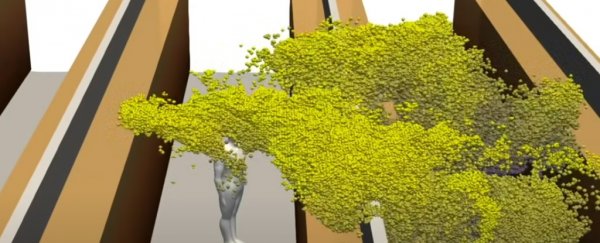A computer-simulated model made by researchers from Finland paints a grim picture of going to the grocery store.
In the simulation, a cough from a person in one aisle spreads a cloud of green particles up and over the shelves into the aisle next to it.
The simulation shows the cough spreading aerosolised particles – droplets small enough to stay suspended in the air and move freely.
Experts said the model should be taken with a grain of salt.
"Our risk of acquiring it and getting enough of that virus aerosol is completely unknown," said Kumi Smith, an assistant professor of epidemiology and community health at the University of Minnesota.
The video "gives the impression that any shared airspace will lead to transmission," but evidence has yet to support that, Smith said.
'An infectious dose'
The larger risk with the coronavirus, according to Smith, is in closer contact with people, such as conversations, where larger droplets from talking, sneezing, or coughing can be transmitted. Those interactions, usually within three feet (roughly one metre), could spread "an infectious dose."
William Schaffner, a professor of preventative medicine and infectious diseases at Vanderbilt University Medical Centre, agrees.
"In the real world, droplet transmission within three to six feet accounts for vast majority of transmissions," Schaffner said. "Airborne" particles go farther and stay in the air for longer, but transmission from those smaller droplets "probably doesn't happen very often," he said.
Both experts noted there's little evidence yet about how the coronavirus could spread through the air, but that the model shows the importance of practicing social distancing and precautions like wearing masks.
Masks as 'source control'
Schaffner said that the Finnish model is "reasonable," but "if everybody did what the CDC recommended, that would address the issue."
The Centres for Disease Control and Prevention recommended last week that Americans should wear masks or other facial coverings if they go out in public.
Both experts told Business Insider that masks are most effective at "source control" – using masks to stop potentially spreading the virus to others, rather than using it as a means to protect yourself.
Because people can be infected and not know it, Schaffner said everyone should be wearing masks or coverings like scarves or bandanas in public.
"Any little bit helps," Schaffner said. "Their principal function is to stop spreading. We're all protecting each other."
Why you shouldn't let your guard down with family and friends
There's a misconception that the coronavirus "comes from people that you don't know," Smith said, which leads to people letting their guards down with family and friends.
"We have a tendency to relax our guard with people we're most familiar with," like family and friends outside of our households, Smith said, "but that's where transmissions are taking place."
Wearing masks can also give people a false sense of security, Smith said. Even if you're wearing a mask, she said, you should still keep distance from others and avoid touching your face, as normal.
"Socially distant encounters with close friends are awkward," Smith said. "But that's what this takes and that's what this needs to look like."
This article was originally published by Business Insider.
More from Business Insider:
